Cubase SX 2.0 Review

This article was first written for Keyboards / Home Studio. It is published here with their kind permission, thanks ,o)
Cubase SX 2.0, evolution or revolution ?
Steinberg surprised us by releasing a 2.0 version of Cubase SX just a year after the 1.0 version. Was it absolutely necessary ? Wouldn’t it have been better to improve the first version ? Here are some clues to get the answer...
Generally speaking…
If the switching from VST to SX has been a real revolution for the cubasians, the update from SX 1.0 to SX 2.0 seems to be less violent at first sight. Thus, if the two versions have common specs – un air de famille -, there are many new features, which will have to be found in the depths of the program ! The improvements range from little luxury additions to the complete rewriting of the audio engine, and the re-introduction of VST functions that users had been annoyed to see disappear in SX 1.0. Never satisfied ;o)
First steps
The Cubase SX Box contains a CD, the USB Dongle Key, the "Getting Started" manual and the registration card. Many PDF files are on the CD.
No trouble at all during the installation. If you’re a new user, just install the program and plug the USB Key, that’s all you need to do. If it is an update from SX 1.0, this is more difficult because the SX 1.0 USB Key will still work, but you'll have to update it.....via the internet. This lead to some discussions on Mailing-lists or forums because cracked versions do not force the users to do such boring things. Not false, but beyond that, the access to the internet is fairly widespread nowadays, and the process only takes a few minutes, and will be soon forgotten. Notice that the USB Key update can be done on any computer connected to the Internet. Here are things to reassure the ones who don't have access to the internet, or who don't want to mix DAW and multimedia computer.
At the first start, SX2.0 recovers SX1.0 preferences, so you don’t loose your habits. You just have to be careful with the shared plug-ins folder. There was only one before SX 2.0, now, there can be many. If your plug-ins were located in a well-defined folder, you will have to tell it to SX 2.0 and restart it. If you put them into many folders, check that they still work with other VST applications. This did not work with WaveLab 4.0.
Next steps…
The GUI has been updated and fixed. Some will like it, some won't. I prefered SX 1 style. SX 2 wants to look more professional (which is the case) but it is not as readable, some items having been reduced to a few pixels. However, the GUI can be softly personalized.
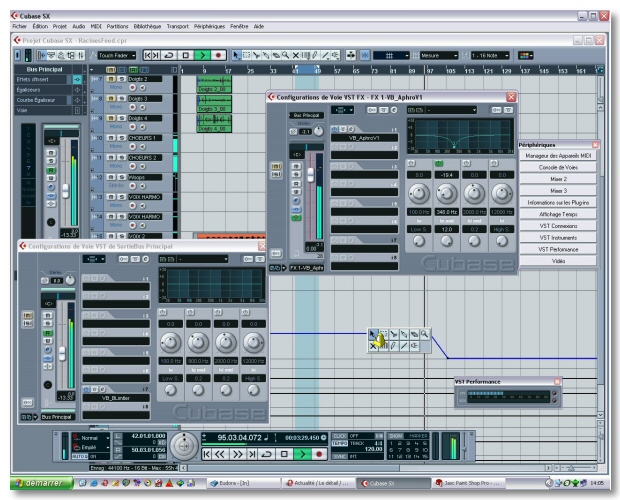
My first test was to load a project recorded with SX 1. The import worked fine, no parameter seems to have been forgotten or to be incorrect. Push the "Play" button, let's go for a walk… The main improvements (sometimes puzzling at first) are rapidly pointed out, and the small details which improve the daily work. Hmmm, after an hour spent to explore the software, I realized that I will have to make choices for this article, and it will be hard to do so!
But the first thing which impressed me is the sound. I was often reserved about the fact that some software could “sound” better than others. But the difference is here, almost flagrant. Cubase SX 2.0 has the new audio engine developed for Nuendo 2.0 (even latency compensation accross all channels) which unanimously impressed the ones who heard it. So, audio…
How it sounds…
When I am talking about Audio engine, this includes the Mixer, the Signal routing, the I/O buses, etc. I will try to sum things up by following the signal path.
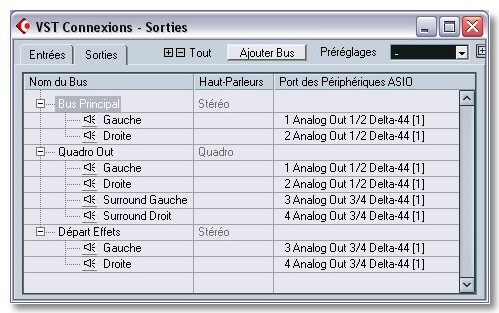 Cubase SX 2 introduces a new concept: virtual Input and Output buses. This means that you have to create buses to which you will affect the physical inputs and outputs of the Audio interface. They can be mono, stereo, and surround up to 6 channels (Cubase SX 2 is surround compatible from the beginning to the end of the audio process). Virtual buses can then be individually assigned to each track of the mixer (for example). Imagine the number of possible combinations! An example realized with a modest DELTA 44 card: I created 1-2 and 3-4 bus inputs, and 1-2 and 3-4 outputs. Then I added an audio track, sound input on 1-2 and effects send to 3-4 output bus, through a multi-effect and the input of the resulting signal in 3-4 bus input!
Cubase SX 2 introduces a new concept: virtual Input and Output buses. This means that you have to create buses to which you will affect the physical inputs and outputs of the Audio interface. They can be mono, stereo, and surround up to 6 channels (Cubase SX 2 is surround compatible from the beginning to the end of the audio process). Virtual buses can then be individually assigned to each track of the mixer (for example). Imagine the number of possible combinations! An example realized with a modest DELTA 44 card: I created 1-2 and 3-4 bus inputs, and 1-2 and 3-4 outputs. Then I added an audio track, sound input on 1-2 and effects send to 3-4 output bus, through a multi-effect and the input of the resulting signal in 3-4 bus input!
The input bus has a very important consequence: it is materialized by a dedicated track in the mixer, on which up to 8 effects and an EQ can be inserted. Now, you can directly add an effect during recording. The interest is for example to have the possibility to add compression when recording voices. Also notice the phase switch and the gain level.
After that, the signal goes into the mixer track. Nothing new until you want to add a Send effect. The effect send rack has simply disappeared! You now have to insert an “FX” track in the project. It will be shown as any other audio track in the mixer. And there is the interesting side of this: an FX track can receive 6 pre-fader/EQ effects and 2 post-fader/EQ effects. Equalisation and Pan (or Surround Pan) are also available, and you can choose the output bus.
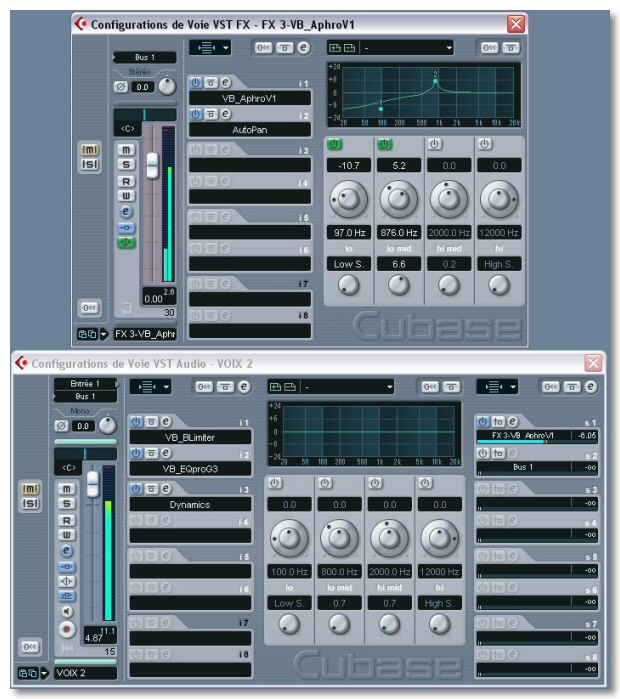
And that's not all! By calling this FX track on an Audio track, we see that the Send effects can also be directed to an FX track, a group or a virtual bus. The routing is easy and powerful. Virtual Studio? It looks more and more like that!
Let's point out that the design of the mixer has been redefined too, and looks like a plane control desk. But we can still find the Cubase SX 1 behaviour. But why has the graduation surrounding the master fader been removed? Even if there is an indicator, but too small, it is not as readable as it used to be. And this is the same with the vu-meters of the extended mixer. The colour variation is not as efficient as a dB graduation.

Well, our signal has done a lot of stuff, let it go out! At the right bottom of the mixer, we can find the virtual bus we set before. Each of them has 8 inserts (which replace the master effect rack) and an equalisation.
At last, the export function offers many possibilities such as export only one bus, or track or group. But the main new feature is the OMF compatibility which lets you share your work with other platforms (if you see what I mean).
As you can see, the Audio engine redesign goes further than it could have seemed!
Let the Freeze be !
This is THE main expected function! The VSTi rack has a new button which gives you the power to freeze the instrument track. Concretely, Cubase creates audio files which replace the VST instrument itself, before its inactivation, in a fully transparent way (nothing changes in the mixer), in order to unload the CPU. If your CPU suffers from the growing greediness of VSTis, this function will save you. Unfortunately, a de-activated VSTi will keep the samples (if there are some) loaded into RAM.
Christmas project!
The main window was also redesigned, but less strikingly. For nostalgic users, the right click tool box is back in an optional way!
The transport panel is now equipped with a Jog/shuttle (how could we do without it?), a direct access to marker, an input/output vu-meter, general volume control… Each of these items can be hidden or shown in the tool bar.

About automation: it is now linked to the event (or to the container or track). You can now drag, drop, copy or paste a track and the automation will follow.

A new recording mode appears: the "stacked" mode. If you record in cycle mode (midi or audio), each loop will generate a distinct event on the track. You will only have to choose which event will have to be activated. These events can, of course, be edited, moved on other tracks like any event.
Another new function is the Time Warp Tool. To be simple, it allows you to edit the Tempo track directly in the project window or in an editor. Its main interest is to let you record the tempo variations of a live recording for example, graphically and visually. This can be done by moving vertical time markers or by creating "break" points.
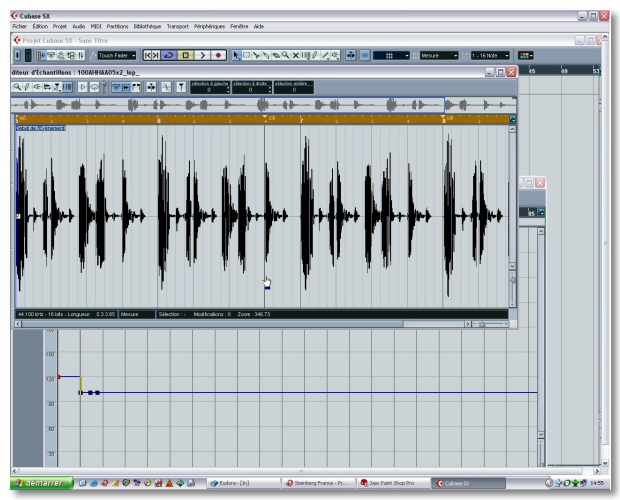
At use, the Time Warp tool is very efficient, and moving a marker using an Event or the waveform is really easy. Those who are working with video will also find an interest in it. Last trick, related to what has been just said: tempo settings can be imported or exported from one project to another.
For what’s left, new functions are not striking enough to be developed here. Let’s mention however a notepad for each track, and the ability to divide horizontally the project window, which allows to scroll the tracks vertically in a division while the tracks in the other window remain steady, and the "Ruler" tracks, which can be added wherever you want, for example for the time reference to be close to the track to edit.
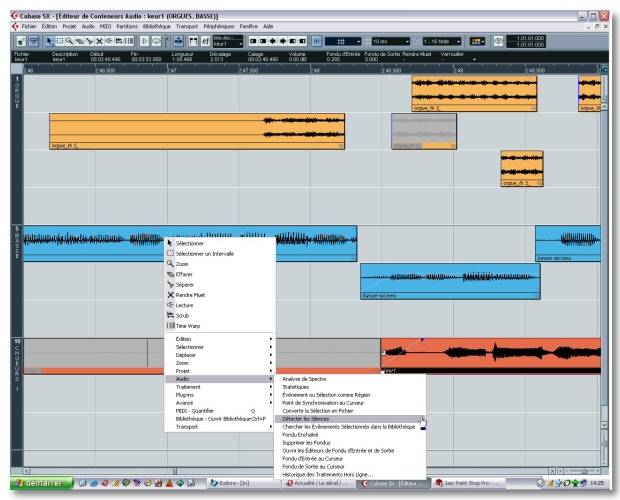
Midi
Cubase was born at the same time as the MIDI norm, it’s been a long time since it handles it easily. Midi functionalities have known some improvements but less than audio ones.
I only noticed the "Tap In Midi to Tempo Track" which transmits the tempo variation of a midi track to the master tempo track. So here is another solution to wedge on a fluctuant Audio part. About chord recognition, it will help those for whom harmony is still a bit mysterious ,o)
The Good Score
Those who use the Score Editor a lot often found this part of Cubase could be largely improved. Cubase SX 2 brings interesting improvements such as the transformation of dynamic events into MIDI events, new symbols for modern guitar (including 12-string guitar tabs!), etc. Well, the bug which makes phones and other incongruous symbols appear in the score is still here! Known solution: go in the Control Panel, open "Fonts", Ctrl-A to select them all, then "Display" / "Actualize", de-select the fonts, and launch Cubase again!
Performances and Hyper Threading
Hyper Threading is an Intel technology which emulates the behaviour of dual-processor on a mono processor machine.
I’ve done a stupid test: read the same song with and without hyper threading on and check performance of Windows XP with the cubase meter. Well, ugh, let’s say I haven't noticed any difference. After having asked a developer for information (Cheers, Vincent!), hyper threading is mainly done to process tasks in parallel, for example having on one hand a perfectly steady audio playback and on the other hand a fluid display.
Then, as the rumour said that SX 2.0 used more resources its elderly brother, I loaded the same project in SX 1. Once again, I could not see the difference. If there is one, it is insignificant.
So, evolution or revolution? Hmmm, both! Evolution, if we consider the improves and other additions, but real revolution if we take into account the re-design of the audio part of the program. This makes Cubase a powerful Audio tool (at last?) and extremely user-friendly, that can now compete with its famous rivals, all the more as Emagic left the PC platform. You will discover the price to get this upgrade by reading the recommended system. Forget your Pentium 200 MMX! In the same way, Cubase SX 2.0 only works on Windows XP/2000 and Mac OSX.
The last piece of information to give you is not the most pleasant. Steinberg decided that there won’t be any demo version available on the net, hoping to slow down the appearing of… well… alternative versions. With the risk of seeing people get these versions before they buy. Paradox :op
- Pros : Audio ( I/O bus, routing, export etc…), sound quality, ergonomics, stability, Time Warp Tool, Freeze function, transport panel
- Cons : Some of the interface items are too small, unreadable graduation of the master fader, no demo version, no paper manual, boring protection
- Possibilities : 18/20
- Ergonomics : 18/20
- Quality/Price ratio : 17/20
- Editor : Steinberg
- Distributor for France : Steinberg-France
- Minimum Required System :
- PC : Processor : Pentium or Athlon 800MHz (1.4 GHz or more recommended), 384 MB RAM (512 MB recommended), Windows 2000/XP Home/XP Professional, ASIO, ASIO compatible or MME sound card, screen resolution 1024x768 (1152x864, dual screen recommended), an available USB port
- MAC : Power Macintosh G4/867 MHz (G4 Dual 1.25 GHz or + recommended), 384 MB RAM (512 MB recommended), Mac OS X.2.5 or more, CoreAudio compatible sound card, screen resolution 1024x768 (1152x864, dual screen recommended), an available USB port
- PC :
- Prix selon Steinberg.net : 799 € (with a VAT of 16 %). Consult your local dealer





